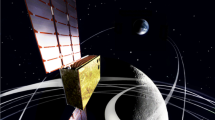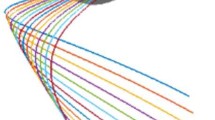Abstract
This study aims to explore more solutions for low-energy transfers to lunar distant retrograde orbits (DROs) from the vicinity of the Earth. Millions of transfer trajectories from a lunar free-return orbit (LFO) to a prescribed DRO were computed using multiple powered lunar flybys (PLFs) and weak-stability-boundary (WSB)-like ballistic transfer. We proposed a two-step design method, consisting of a database creation and trajectory patching, to construct low-energy LFO–DRO transfers in planar bicircular restricted four-body dynamics with the Sun, Earth, and Moon as primary bodies. The parallel computation technique allows the computation of millions of solutions with times of flight (TOFs) up to 135 days and a total velocity impulse (\(\Delta \)V) of no more than 350 m/s, although this design method requires substantial computational load. These solutions help us identify key flight information, such as the \(\Delta \)V–TOF Pareto fronts and launch windows for rendezvous with a station in a DRO. Low-energy transfers to a DRO can be achieved by exploiting single or multiple PLFs and WSB-like ballistic arcs at the expense of elongated TOFs. Moreover, triple PLFs render many more options for the spacecraft to accomplish the rendezvous of DROs. The WSB-like ballistic arcs to a DRO in this study exhibit new features compared with conventional and traditional WSB concepts.




















Similar content being viewed by others
References
Belbruno, E., Miller, J.: Sun-perturbed earth-to-moon transfers with ballistic capture. J. Guid. Control. Dyn. 16, 770–775 (1993)
Bosanac, N., Cox, A., Howell, K., Folta, D.: Trajectory design for a cislunar cubesat leveraging dynamical systems techniques: the lunar icecube mission. Acta Astronaut 144, 283–296 (2018)
Brophy, J., Friedman, L., Culick, F.: Asteroid retrieval feasibility. In: 2012 IEEE Aerospace Conference, pp. 1–16. IEEE (2012)
Broucke, R.: Periodic orbits in the restricted three-body problem with Earth-Moon masses. Technical Report 32-1168. Jet Propuls. Lab. Cal. Tech (1968)
Capdevila, L., Guzzetti, D., Howell, K.: Various transfer options from Earth into distant retrograde orbits in the vicinity of the Moon. Earth 1, L5 (2014)
Capdevila, L., Howell, K.: A transfer network linking earth, moon, and the triangular libration point regions in the earth-moon system. Adv. Sp. Res. 62, 1826–1852 (2018)
Chen, H., Canalias, E., Hestroffer, D., Hou, X.: Effective stability of quasi-satellite orbits in the spatial problem for phobos exploration. J. Guid. Control. Dyn 43, 2309–2320 (2020)
Craig, D., Herrmann, N., Troutman, P.: The evolvable mars campaign-study status. In: 2015 IEEE Aerospace Conference, pp. 1–14. IEEE (2015)
Demeyer, J., Gurfil, P.: Transfer to distant retrograde orbits using manifold theory. J. Guid. Control Dyn. 30, 1261–1267 (2007)
De la Fuente Marcos, C., De la Fuente Marcos, R.: Asteroid (469219) 2016 HO3, the smallest and closest earth quasi-satellite. Monthly Notices Roy. Astron. Soc. 462, 3441–3456 (2016)
Folta, D., Bosanac, N., Guzzetti, D., Howell, K.: An earth-moon system trajectory design reference catalog. Acta Astronaut 110, 341–353 (2015)
Gates, M., Muirhead, B., Naasz, B., McDonald, M., Mazanek, D., Stich, S., Chodas, P., Reuter, J.: NASA’s asteroid redirect mission concept development summary. In: 2015 IEEE Aerospace Conference, pp. 1–13. IEEE (2015)
He, B., Shen, H.: Solution set calculation of the sun-perturbed optimal two-impulse trans-lunar orbits using continuation theory. Astrodynamics 4, 75–86 (2020)
Hénon, M.: Numerical exploration of the restricted problem. VI. Hill’s case: non-periodic orbits. Astron. Astrophys. 9, 24–36 (1970)
Jansson, S.W.: Stable orbits about the martian moons. Master Thesis. Air Force Institute of Technology, Ohio (1990)
Jesick, M., Ocampo, C.: Automated generation of symmetric lunar free-return trajectories. J. Guid. Control. Dyn. 34, 98–106 (2011)
Liu, L., Hou, X.: Deep space probe orbital mechanics. Electronic Industry Press, Beijing (2012) (in Chinese)
McCarthy, B., Howell, K.: Leveraging quasi-periodic orbits for trajectory design in cislunar space. Astrodynamics 5, 139–165 (2021)
Mikkola, S., Brasser, R., Wiegert, P.: Asteroid 2002 VE68, a quasi-satellite of Venus. Monthly Notices Roy Astron. Soc. 351, L63–L65 (2010)
Mingotti, G., Topputo, F., Bernelli-Zazzera, F.: Efficient invariant-manifold, low-thrust planar trajectories to the moon. Commun. Nonlinear Sci. Numer. Simul. 17, 817–831 (2012)
Murakami, N., Yamanaka, K.: Trajectory design for rendezvous in lunar distant retrograde orbit. In: 2015 IEEE Aerospace Conference, pp. 1–13. IEEE (2015)
Parker, J., Bezrouk, C., Davis, K.: Low-Energy Transfers to Distant Retrograde Orbits, pp. 15–311. Adv. Astronaut. Sci. Spacefl. Mech, AAS (2015)
Pushparaj, N., Baresi, N., Kawakatsu, Y.: Design of transfer trajectories between planar and spatial quasi-satellite orbits. In: AIAA Scitech 2020 Forum, pp. 1–13. Orlando, FL (2020)
Strange, N., Landau, D., McElrath, T., Lantoine, G., Lam, T.: Overview of mission design for NASA asteroid redirect robotic mission concept. In: 33rd International Electric Propulsion Conference. Washington, D.C (2013)
Szebehely, V.: Theory of Orbits: The Restricted Problem of Three Bodies. Yale University, New Haven, CT (1967)
Tan, M., Zhang, K., Lv, M., Xing, C.: Transfer to long term distant retrograde orbits around the moon. Acta Astron 98, 50–63 (2014)
Vaquero, M., Howell, K.: Leveraging resonant-orbit manifolds to design transfers between libration-point orbits. J. Guid. Control. Dyn. 37, 1143–1157 (2014)
Wajer, P.: Dynamical evolution of Earth’s quasi-satellites: 2004 GU9 and 2006 FV35. Icarus 209, 488–493 (2010)
Wang, W., Shu, L., Liu, J., Gao, Y.: Joint navigation performance of distant retrograde orbits and cislunar orbits via LiAISON considering dynamic and clock model errors. Navigation 66, 781–802 (2019)
Wang, Y., Wu, X.: Analysis of Phobos’ dynamical environment considering effects of ephemerides and physical libration. Monthly Notices Roy. Astron. Soc. 497, 416–434 (2020)
Welch, C., Parker, J., Buxton, C.: Mission considerations for transfers to a distant retrograde orbit. J. Astronaut Sci 62, 101–124 (2015)
Whitley, R., Martinez, R.: Options for staging orbits in cislunar space. In: 2016 IEEE Aerospace Conference, pp. 1–9. IEEE (2016)
Xu, M., Xu, S.: Exploration of distant retrograde orbits around Moon. Acta Astronaut 65, 853–860 (2009)
Yamakawa, H., Kawaguchi, J., Ishii, N., Matsuo, H.: A numerical study of gravitational capture orbit in the Earth–Moon system. In: Spaceflight Mechanics 1992, Proceedings of the 2nd AAS/AIAA Meeting, pp. 1113–1132. Colorado Springs (1992)
Yamakawa, H., Kawaguchi, J., Ishii, N., Matsuo, H.: On Earth-Moon transfer trajectory with gravitational capture. Adv. Astronaut Sci 85, 397 (1993)
Zhang, R., Wang, Y., Zhang, H., Zhang, C.: Transfers from distant retrograde orbits to low lunar orbits. Celest. Mech. Dyn. Astron 132, 1–41 (2020)
Acknowledgements
This study was supported by the Key Research Program of the Chinese Academy of Sciences (Grant No. ZDRW-KT-2019-1-0102).
Author information
Authors and Affiliations
Additional information
Publisher's Note
Springer Nature remains neutral with regard to jurisdictional claims in published maps and institutional affiliations.
This article is part of the topical collection on Toward the Moon and Beyond.
Guest Editors: Terry Alfriend, Pini Gurfil and Ryan P. Russell.
Appendices: Representative LFO−DRO transfer trajectories
Appendices: Representative LFO−DRO transfer trajectories
Transfer trajectories of the Pareto optimal solutions in Fig. 8 in the Earth–Moon rotating frame (the first blue are computed in PCRTBP, while the green and second blue arcs were computed in PBRFBP)
Transfer trajectories of the Pareto optimal solutions presented in Fig. 8 in the Sun–Earth rotating frame (the first blue arc was computed in PCRTBP, while the green and second blue arcs were computed in PBRFBP)
The transfer trajectories of I−VI shown in Fig. 8 plotted in the EMR and SER frames are shown in Figs. 21 and 22, respectively.
Transfer trajectories of the Pareto optimal solutions presented in Fig. 9 in the Earth–Moon rotating frame (the first blue and green arcs were computed in PCRTBP, while the second blue arc was computed in PBRFBP)
Transfer trajectories of the Pareto optimal solutions presented in Fig. 9 in the Sun–Earth rotating frame (the first blue and green arcs were computed in PCRTBP, while the second blue arc was computed in PBRFBP)
The spacecraft reaches the perilune twice and conducts double PLFs when it moves along the trajectory (blue–green–blue arcs), where the first blue arc is the LFO–perilune track, the green arc is the perilune–perilune track, and the second blue arc is the perilune–DRO track. Transfer I has a short flight time, while transfer II–VI uses the WSB-like arc, where the first PLF places the spacecraft into a WSB-like trajectory arc, and the second PLF places the spacecraft into a trajectory that intersects with the target DRO. The orbital states at the maneuvers of the two transfers in the Earth–Moon rotating frame are presented in Table 8, where \(\phi \) is the phase of the Sun, \(\hbox {P}_i\) is the i-th perilune, and \(t = 0\) when the spacecraft arrives at the second perilune.
Transfer trajectories of the Pareto optimal solutions presented in Fig. 10 in the Earth–Moon rotating frame (the first blue and green arcs were computed in PCRTBP, while the other arcs were computed in PBRFBP)
Transfer trajectories of the Pareto optimal solutions presented in Fig. 10 in the Sun–Earth rotating frame (the first blue and green arcs were computed in PCRTBP, while the other arcs were computed in PBRFBP)
The transfer trajectories of I–V in Fig. 9 plotted in the EMR and SER frames are shown in Figs. 23 and 24, respectively. In the two figures, the perilune–perilune arcs (green arc) appear to have a figure-8 shape in the EMR frame and orbits the Earth twice in the SER frame. In transfers III–V, two PLFs occur before the WSB-like arc. The orbital states at the maneuvers of the five transfers in the Earth–Moon rotating frame are presented in Table 9, where \(t = 0\) when the spacecraft arrives at the DRO.
The transfer trajectories of I–V in Fig. 10 plotted in the EMR and SER frames are shown in Figs. 25 and 26, respectively. Four segments can be identified, including the LFO-to-perilune trajectory (blue lines), two perilune-to-perilune trajectories (green lines and blue lines), and the perilune-to-DRO trajectory (red lines), in which transfers III–VI used the WSB-like arc. The states at the maneuvers of the six transfers in the EMR frame are presented in Table 10, where \(t = 0\) when the spacecraft arrives at the third perilune.
The states at the maneuvers of the representative solutions in Fig. 7 in the EMR frame are presented in Table 11, where \(t = 0\) when the spacecraft arrives at the DRO.
Rights and permissions
About this article
Cite this article
Peng, C., Zhang, H., Wen, C. et al. Exploring more solutions for low-energy transfers to lunar distant retrograde orbits. Celest Mech Dyn Astr 134, 4 (2022). https://doi.org/10.1007/s10569-021-10056-2
Received:
Revised:
Accepted:
Published:
DOI: https://doi.org/10.1007/s10569-021-10056-2
Keywords
- Low-energy transfers
- Lunar distant retrograde orbits
- Powered lunar flybys
- Weak-stability-boundary-like transfer
- Planar bicircular restricted four-body problem










